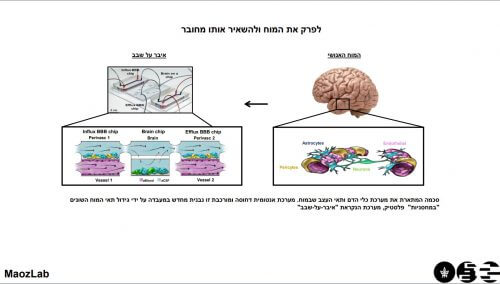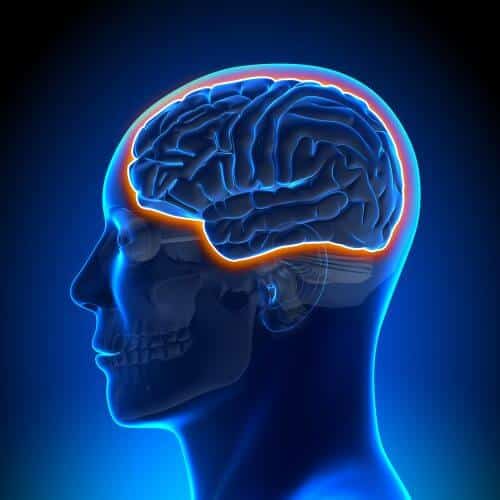Says Dr. Ben Maoz from the Department of Biomedical Engineering and the Sagol School of Neuroscience at Tel Aviv University, whose research was published this week in Nature Biotechnology. In addition, the researchers discovered how the drug crystal meth affects brain and blood cells in the barrier between them. According to him, biological chips could be used as a substitute for experiments on animals

"A brain system on a chip revealed to us new details about blood-brain barrier activity, which will help in the treatment of diseases such as Parkinson's and Alzheimer's." Says Dr. Ben Maoz from the Department of Biomedical Engineering and Segol School of Neuroscience at Tel Aviv University, who, as part of a study he carried out together with researchers from the Weiss Institute, Harvard University and the Swedish KTH Institute, created a model that imitates the passage of fluids from the blood to the human brain through a "super organ" "Organ-on-a-Chip". The results of the groundbreaking research were published (Monday, 20.8.18) in the journal Nature Biotechnology.
In an interview with the Hidan website, Dr. Maoz explains that the system he built proved that the blood vessels that carry blood to the brain are not only a tube that regulates the amount of blood and neurons, but also have a direct and very significant communication with the neurons, so significant that every chemical released by the blood vessels affects the activity of the neurons. The second discovery was actually a confirmation of the model, when the researchers fed the blood vessels with the dangerous drug crystal meth and showed that the response of the nerves corresponds to what is known about the effect of the drug and even discovered effects that were not known until now. "This is a study that cannot be carried out in mice, for example, because the brain is a compressed organ, and with existing methods it is not possible to measure interactions between different cells.
"The human brain consists of one hundred billion neurons, which control our every thought and action, and is the most complex and delicate organ in the human body. Because of this, the brain needs special protection from toxins. The blood vessels that supply the brain with oxygen and nutrients are very selective regarding the substances that can pass from the blood to the brain and vice versa, which is why they are called the brain-blood barrier. Beyond being a physical barrier, the barrier actively regulates the functions of the brain, but until today it was not clear how this regulation was done in practice."
"It is known that there is a connection between the blood vessels of the brain and the brain activity itself," explains Dr. Maoz. "MRI devices work on this principle, for example: when we exercise a certain area of the brain, the blood vessels flow more blood to the area - and the device measures the increased activity. However, it is very difficult to understand the interaction between blood vessels and neurons at the cellular level. Naturally, it is not possible to work with a living human brain, whereas cells in cultures do not reflect this connectivity. The connectivity between the cells greatly affects their properties. Nerve cells that grow in a Petri dish are different in their properties from nerve cells that are attached to blood vessel cells."
The solution Dr. Maoz found is an organ-on-a-chip: growing human tissue from donated tissues and stem cells that have been converted into organ cells, so that the activity of the organ can be simulated in a controlled way and the different parts of the brain can be connected. In the last four years, Dr. Maoz has built a living system that simulates the interactions of the human brain: brain tissue-on-a-chip, connected to two vascular tissues and nerve cells that simulate the blood-brain barrier.
"An organ-on-a-chip is a technology that was invented about a decade ago," explains Dr. Maoz, "but its application in understanding basic biological processes in the brain was very limited. The reason for this was that until now we have examined the brain tissue in isolation from the blood barrier. We created a complete system and proved that it works. So, for example, we inserted methamphetamine, the drug from the 'Breaking Bad' series, into the blood cell chips and saw that we get the same symptoms on the brain chip that are seen in people who use the drug."
The idea is to take human cells and mimic the function of a certain organ inside a plastic cartridge that we call a chip. For example, the kidney is a filter. If we manage to take a person's kidney cells, make a filter out of them and put them in a piece of plastic, we will call it a kidney on a chip. The heart is a pump - if I manage to take human heart cells and build something from it that contracts like a pump, we'll call it a heart on a chip. This can be done for any organ. To take its functionality through tissue engineering technologies, put it in a plastic cartridge and grow it in a laboratory.
"The advantage of imitating organs on a chip is that you can connect all these chips, for example kidneys, heart and intestines, and see how a drug for one organ affects other organs, for example the side effects of a drug for the heart on the liver, a type of research that is very difficult to carry out in any other way. Additionally, since the cells I'm working with are human cells, the entity I'm building in the lab is a mini-human on a chip. In the present study we examined the brain. The brain is a complex organ in which there are many areas that each have their own function, but they all have a common denominator - they contain nerves that communicate with the blood vessels through the blood-brain barrier. This area is particularly interesting because any chemical that reaches the brain through the blood has to cross the blood-brain barrier. The barrier makes sure that toxins and bacteria do not enter. On the other hand, the same mechanism also makes it difficult for drugs, consisting of large molecules, to enter the brain."
"We took this area of the interaction between the blood vessels of the brain and the nerve cells of the brain and decomposed it into two chips - one mimics the nerve cells - the neurons - and the other the blood vessels and we preserved the communication between the two chips. This model is of great interest to pharmaceutical companies looking for drugs for neurodegenerative diseases such as Alzheimer's and Parkinson's, which are very difficult to cure because the drugs cannot be transported through the blood-brain barrier. And apart from that, it is of course of interest to neuroscientists involved in basic science."

A substitute for animal testing
"Over sixty percent of the drugs that successfully undergo experiments on animals fail at the stage of experiments on humans," says Dr. Maoz. "Despite the similarity, a mouse brain is simply not a human brain. Moreover, neurodegenerative diseases are diseases that are mainly characteristic of humans. Although mice are used to simulate diseases such as Alzheimer's, it is not exactly the same. For this reason, we aim to build a brain-on-a-chip from human cells, which will simulate the functioning of the brain in a normal state and in disease states. The brain we built in the laboratory allows us to examine complex biological processes and the effect of drugs on humans without endangering anyone, and without harming the animal, and this in an efficient way than ever before. An organ-on-a-chip is not just a research tool. The FDA has already initiated the development of organs-on-chips as part of the drug development process, and a number of collaborations have already been established between my laboratory and pharmaceutical companies from Israel and the world."
"These days, we are adding additional organs, such as the immune system and liver, with the aim of finally building a complete model of the human body on chips, which will replace the need for animals in the laboratory and give researchers unprecedented resolutions for the effect of various chemicals on the human brain - and the biological development of various diseases that are unique to humans ". says Dr. Maoz.
"If we go by a prediction from the field of science fiction, the aspiration is to reach a state of developing a whole person on chips, with each chip representing a different organ in his body, when it will be possible to take a cell from his skin, turn it into a stem cell and from there into the other cells, and then test the effect of a drug on the patient The specific one with the help of the organs on a chip", concludes Dr. Maoz.
More of the topic in Hayadan:

2 תגובות
I heard your lecture on the 10th of November during the brain research course,
The lecture was clear and led me to look for additional relevant material on the Internet
Thanks
Most interesting
I heard your lecture as part of brain research on Sunday the tenth of November in Gillot.
The lecture was clear and led me to search the Internet for additional material in the field
Thanks